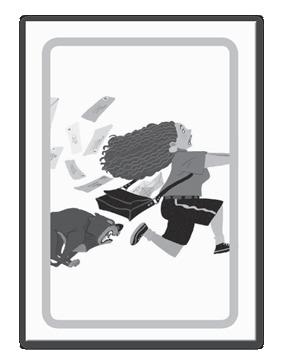



Aims of the game
That’s my job! is a game for A2 level students. By matching pictures, words and sentences, students memorise and practise English vocabulary and language structures related to jobs and professions. The game can be played at home with friends, or in the classroom with the teacher, where it becomes an excellent teaching tool.
Contents
The game contains:
- two packs of 60 cards, with each pack divided into six colours
- a pack of 12 cards with the solutions




- a playing board
- a dice
- an instruction booklet
Didactic characteristics:
- The colourful and fun illustrations immediately convey the meaning of words without the need for translations.
- The names of the jobs encourage students to concentrate, memorise and match the words to the corresponding pictures.
- The sentences on the game board allow students to enrich their vocabulary and language structures and also encourage students to use simple, complete sentences to describe the skills of each job or profession.
How to play
The teacher or group leader puts the game board on the table, makes the dice and divides the cards into six coloured packs. The answer cards remain available so that players can check their answers. The youngest player starts the game: he/she throws the dice and moves along the game board according to the number on the dice. The player reads the sentence and looks for the matching job or profession. If the player matches correctly, he/she takes a card from the pack corresponding to the colour of the space with the correctly guessed job, and play passes to the player on the left.
The winner is the player with the most cards at the end of the game or at the end of a set time limit.
Games and teaching activities
Here are some ideas for fun teaching activities that are useful for checking students’ understanding.
Memory game
The teacher or group leader chooses several cards from the different packs (the number of cards depends on the language level of the group). Place the cards face down on the table: put the picture cards on the left and the cards with job names on the right. Players take turns to find a card from both packs. If the cards do not match, they are put back face down in the correct pack. If the two cards match, the player takes them and sets them aside.
The winner is the player with the most cards at the end of the game or at the end of a set time limit.
One minute!
The teacher or group leader divides the players into two teams and puts a number of cards with the job names face up on the table. Give the players a minute to look at the cards and memorise them, before turning them over. The team that correctly remembers and writes the most names is the winner.
As an extension activity, players look and memorise the pictures. In this case, players have to mentally associate the picture to the corresponding word and then write the correct name of the job.
Bring me…
The teacher or group leader puts a certain number of cards on the table and asks the players to go to the other side of the classroom. He/She then says: ‘Bring me… the police officer.’ The players have to run to the table, identify as quickly as possible the card that refers to the requested job, then take and hand over the card to the game leader. Players win one point for each correctly identified card. The player with the most points is the winner. The game can also be played in teams.
True or False?
The teacher or game leader divides the players into two teams with the same number of players. The two teams stand in single file next to each other. Put two chairs at the other end of the room: one has a ‘True’ sign and the other has a ‘False’ sign. The teacher or the group leader chooses one card from the solutions cards, reads the card out loud and completes it so that it is true or false: for example, The shop assistant works in a shop. / The postman works in a shop. The two players at the head of the lines have to run towards the chair with the ‘True’ or ‘False’ sign, according
to the content of the sentence. The first player to sit down on the correct chair wins a point. Then the two players return and stand at the end of the line. The team with the most points is the winner. As an extension activity, players can take the role of the teacher or the group leader and take turns to create a sentence.
Who am I?
The teacher or group leader invites a player to stand aside from the group. He/she then chooses a card from the pack with job names, and without showing it to the isolated player, shows the card to the other players. In this way the isolated player does not know what job he/she has to represent, and he/she has to discover the job by asking specific questions. The other players can only answer with Yes or No. The player has to guess the work environment, what tools he/she uses and then the name of the job. Here are some example questions:
Do I work in an office? In the open air? In a shop?
Do I use a computer? A camera? Cards and coloured pencils? Do I sell something? Repair items? Draw? Look after people?
The player can consult the pack of picture cards to find ideas and help form further questions.

When he/she is convinced of the job, the player says the word out loud or writes it on a piece of paper and shows it to the other players. The game can continue until the job is correctly guessed or according to a set time limit.



